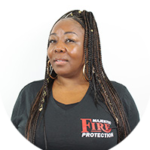NFPA 17 Standard for Dry Chemical Extinguishing Systems

Fire is one of the most devastating humanmade disasters, occurring frequently and engulfing thousands of lives every year. Losing your beloved one and property in front of your eyes is the scariest thought. But, it is not impossible to combat.
Fire can be controlled through adequately installed and functional fire suppression systems. In this regard, Dry Chemical Extinguishing Systems are a great choice, especially when the sprinkler system is not available.
Dry Chemical Extinguishing Systems
These systems are effective against class ABC fire, and for industrial applications, they act as automatic fire suppression systems.
Dry chemical extinguishing systems release a composition of dry chemical powder to extinguish the fire. The most common fire extinguishing powders used in Dry chemical extinguishing systems include:
- sodium bicarbonate
- potassium bicarbonate
- monoammonium phosphate
- and urea complex.
Their only disadvantage is that they throw a lot of powder at the hazard site, which needs to be cleaned up, but that does not matter when compared to these life-saving systems' significance.
NFPA 17: Standard for Dry Chemical Extinguishing Systems
Like the other fire suppression systems, dry extinguishing chemical systems must comply with NFPA standards. In this regard, NFPA 17:Standard for Dry Chemical Extinguishing Systems provides all essential requirements for purchasing, designing, installing, approving, and inspecting these systems.
According to NFPA 17, Dry chemical extinguishing systems are designed to provide maximum protection against the fire in the following cases:
- Combustible liquids and gases
- Combustible solids that melt in the fire
- Electrical hazards such a transformers and circuit breakers
- Combustibles including cloth, paper, and wood
- Kitchen hazards
Selection of appropriate Operating devices
NFPA 17 provides recommendations for operating devices as well. The standard illustrates that all operating devices used for dry chemical extinguishing systems should encounter the hazard. They should be marked with their minimum and maximum temperature limits, and they should at least withstand the temperature range of 0°C to 49°C.
Requirements for Discharge Nozzles
Discharge nozzles made up of corrosion-free material such a brass or stainless steel shall be used for the system. While selecting discharge nozzles, ensure that they are of adequate strength and capable of enduring fire exposure malformation. They should be of noncombustible material with permanent identification marks.
Another vital point that must be kept in mind while selecting discharge nozzles is blow off caps or devices to hinder the entrance of moisture in piping.
NFPA 17 instructions for manual actuators
NFPA 17 specifies that all devices, including the manual actuators, shall be designed to protect in case of fire. For this purpose, all manual actuators of Dry chemical extinguishing systems can have pictographs, but the lettering size should be at least size 6.35 mm in height.
Guidelines for selection of pipes and fittings
All the pipes and fittings required for the system shall be according to the requirements of NFPA 17. According to NFPA 17 requirements, pipe and fittings, all be of noncombustible material, and they shall be capable of withstanding maximum expected pressure in the piping system.
They should be appropriately galvanized and made up of corrosion-resistant stainless steel, brass, or copper material.
Quantity of dry chemicals for dry chemical extinguishing systems
According to NFPA 17, if the area is mostly enclosed with less than 15% openings, a total flooding system can be used. But if the area of unclosable spaces is less than 1%, no extra dry chemical is needed. If the unclosable openings are present between 1-5 %, an extra dry chemical suppressant can be employed.
Other NFPA 17 requirements for Dry Chemical Extinguishing Systems
Other requirements of NFPA 17 include:
Only trained personnel shall design, install, and maintain dry chemical systems. It specifies that only Authorities having jurisdiction shall be competent to approve the fire protection system.
Under the supervision of NFPA 17, all the equipment or materials used in dry extinguishing chemical systems should be appropriately labeled with the identification mark of the authorizing organization.
Automatic detectors used in the system should be listed. They should be capable of detecting heat, flame, smoke, vapors, or other fire-related hazardous conditions.
Proper coiling of hose around the hose reel to ensure easy uncoiling in case of emergency.
Hose nozzle shall be devised in such a way that one person can easily handle it. It should have an incorporated shutoff device to regulate the flow of dry chemicals.
The dry chemical used in this fire suppression system shall not be replaced with another until approved by the testing laboratory and recommended by AHJ. Different types of dry chemicals should not be mixed without authorized personnel's permission, as they may cause bodily harm.
The carbon dioxide used as expellant gas shall not have a vapor pressure of less than 99.5%, and its water content should not exceed 0.01 %.In the case of nitrogen gas as an expellant, it should have a dew point of (-52.2°C) or lower.
Conclusion
Dry chemical extinguishing systems are designed to control the fire immediately. The sooner the fire can be contained, the lower the chances of causalities and property damage. However, these fire suppression systems' designs and installation conditions are not the same for all the buildings. They can work effectively only when they are installed according to the structure and requirements of NFPA 17.



